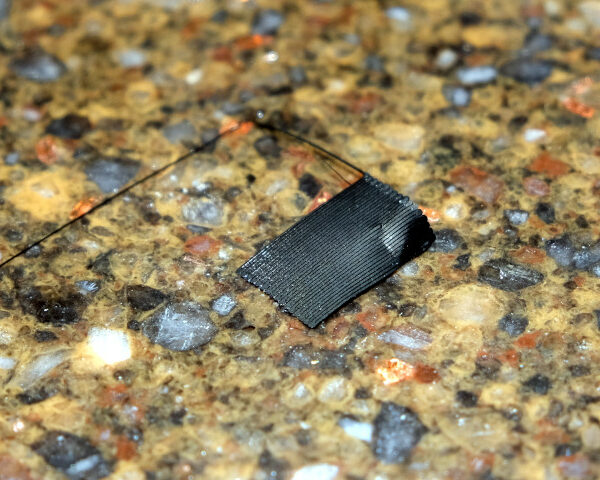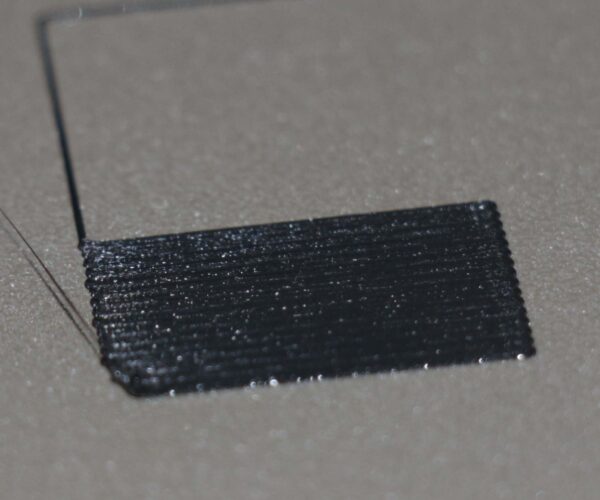What are printing paraleters for firmware first layer calibration?
When I do First layer calibration I get nice print. Everything seems fine. Filament sticks to the plate nicely.
But when I run some print it ends up horrible. Filament does not stick.
I use all default values in PrusaSlicer with intention to tweak them to get solid prints. Problem is I do not know what to tweak.
How can I find out what parameters are used to generate First layer calibration print firmware so I can match them?
Please run a first layer Z calibration and show us the resulting print *on the print sheet*.
Cheerio,
RE: What are printing paraleters for firmware first layer calibration?
I have no issue with first layer calibration. It works very nice and calibration print is good in every sense.
Problem is when I do any print it does not stick to the plate. I would like to set PrusaSlicer to have the same print quality as in First layer calibration.
Humour us: run a first layer Z calibration and show us the resulting print *on the print sheet*.
Cheerio,
I would have liked to see more of the zigzag but it seems the layer is reasonable, it could probably go a fraction lower, don't sweat it.
There are signs your filament is damp, this has been a huge problem recently, dry it. Then the next step is to give your print-sheet a really thorough clean, look up threads here...
Your calibration settings are automatically stored, there is no need to apply them, it is done for you.
Cheerio,
RE: What are printing paraleters for firmware first layer calibration?
This is newly open filament. However this issue happens with other filaments too. Drying did not make a difference.
As I sad, First layer calibration print is good. Problem is when I print something sliced in PrusaSlicer. Then it does not stick so well.
Something is different in printing parameters PruseSlicer applies. I can make it work OK when I cut First layer speed from default 20 mm/s to 10mm/s but that is noticeably slower than how firmware prints calibration pattern.
Make certain the build sheet is absolutely clean.
Cheerio,
RE: What are printing paraleters for firmware first layer calibration?
Make certain the build sheet is absolutely clean.
Cheerio,
Have you actually read what I posted? Your suggestions seem totally irrelevant to issue I am talking about.
RE: What are printing paraleters for firmware first layer calibration?
Follow https://forum.prusa3d.com/forum/original-prusa-i3-mk3s-mk3-assembly-and-first-prints-troubleshooting/life-adjust-z-my-way/ (you can also create your own print with 0.2mm height). That way you can actually test your slicer settings and check how the first layer turns out. Might be speed, might be temperature, might be the actual Z offset, might be the sheet cleanliness (from my experience usually its the latter - even when the Z calibration seems fine larger print will not stick with an unclean sheet).
Have you actually read what I posted?
Yes. Clean the build sheet.
Cheerio,
RE: What are printing paraleters for firmware first layer calibration?
Have you actually read what I posted?
Yes. Clean the build sheet.
Cheerio,
Well, I must admit you are so rude. This is not what one could expect in such community, but I guess, there are always bad apples everywhere.
RE: What are printing paraleters for firmware first layer calibration?
Well, I must admit you are so rude. This is not what one could expect in such community, but I guess, there are always bad apples everywhere.
Its just that most people have learned (the hard way, sometimes), that most adhesion issues are down to two reason: wrong Z-adjust, and a print sheet which is not clean. It basically never is caused by print parameters (apart from printing too fast, or with wrong temperatures).
Hence we want to make sure that these two issues really are covbered before looking at anything else. Esp. since these two issues _cannot_ be solved with slicer configurations.
RE: What are printing paraleters for firmware first layer calibration?
Follow https://forum.prusa3d.com/forum/original-prusa-i3-mk3s-mk3-assembly-and-first-prints-troubleshooting/life-adjust-z-my-way/ (you can also create your own print with 0.2mm height). That way you can actually test your slicer settings and check how the first layer turns out. Might be speed, might be temperature, might be the actual Z offset, might be the sheet cleanliness (from my experience usually its the latter - even when the Z calibration seems fine larger print will not stick with an unclean sheet).
This is what I ended up doing. I am using test print model in slicer to adjust first layer and all other parameters.
That is not an issue. Thing is why using the first layer calibration in firmware differs in results? It has nothing to do with cleaning the bed as in both cases I am just printing one layer thick test.
This did not happen before. I am printing for more than two years. Doing the first layer calibration from firmware was always good starting point as it should be.
RE: What are printing paraleters for firmware first layer calibration?
That is not an issue. Thing is why using the first layer calibration in firmware differs in results? It has nothing to do with cleaning the bed as in both cases I am just printing one layer thick test.
You should adjust first layer in the slicer. Thats what the live-Z-adjust is for. PrusaSlicer assumes the first layer is 0.2mm. It will position the nozzle at this heigth. Any correction to the nozle height should be made on the printer, using the Live-Z-adjust. It will be stored under the sheet settings then.
Which filament do you print with, and which slicer profile do you use? Running the default slicer settings for e.g. Prusament should result in about the same print profile as the build in Z-calibration print (I think the built-in one is a bit slower than the default profile, though).
RE: What are printing paraleters for firmware first layer calibration?
Well, I must admit you are so rude. This is not what one could expect in such community, but I guess, there are always bad apples everywhere.
Its just that most people have learned (the hard way, sometimes), that most adhesion issues are down to two reason: wrong Z-adjust, and a print sheet which is not clean. It basically never is caused by print parameters (apart from printing too fast, or with wrong temperatures).
Hence we want to make sure that these two issues really are covbered before looking at anything else. Esp. since these two issues _cannot_ be solved with slicer configurations.
I am not dumb. Of course I cleaned the bed. I guess, after two years of printing I know how to clean it. And I did it three times actually. I even bought new plate suspecting that old one was damaged somehow (I actually bought two, second one textured to see if that could help). I came here to ask after I excluded bed cleanliness and plate quality as an issue.
As I noted, I used first layer calibration to set Z level and I got good setup. I went to the point when lowering it a bit down causes unwanted squeeze. I get good filament stick to the bed, everything as right as it should be. Then I do test print from slicer with all default values for printer and filament and it is not good at all. Something is different. I just wanted to find out what is the difference, hoping that printing parameters for firmware first layer calibration are known.
Then I received constant insulting comments from diem.
RE: What are printing paraleters for firmware first layer calibration?
Can you show a picture of how the test print done with a sliced thin object looks like? (maybe even upload the slicer project file so we can see the actual settings). Images are better to check than a 'not good at all', this could mean everything.
You mentioned that you did follow the Live-Z-My-Way procedure - this should give you a good first layer for object sliced regularly? When you use this Z-height, how does the built-in Z-Calibration print end up (assuming yo do not adjust Z heigth during this print)?
When the first layer looks good for the built-in calibration (which uses the front left corner), but bad in the center (using the test object), the print bed might be warped too much. (The mesh bed probe should compensate this, but is can still cause issues in my experience)
RE: What are printing paraleters for firmware first layer calibration?
Btw: the first layer calibration GCODE can be found in the MK3 firmware, the respective file is at https://github.com/prusa3d/Prusa-Firmware/blob/MK3/Firmware/first_lay_cal.cpp . When I read it correctly the feedrate for all movement is set as 'G1 F1080' with an acceleration of 'M204 S1000'.
RE: What are printing paraleters for firmware first layer calibration?
I'm going to speak very freely here.
When I joined this forum (probably February or so, 2000, just before the Covid hit the fan) one thing I found somewhat annoying was the almost knee-jerk response of 'Clean your plate and clean it my way' to anyone reporting almost any type of first layer issue. And yes, I found a number of said responses to be rude and condescending! (Keeping in mind, of course, that this is an on-line forum, and nonverbals are not visible, plus the fact that this is an international forum and nuances between speakers of various native tongues are often not communicated well.)
It's currently not as bad as it was maybe two years ago, but I still notice a tendency of some to 'talk down to' others (or at least appear to on the on-line forum) who are having issues.
The thing is, we're mostly all adults, and by now we know how to clean something and we know when something is clean or is not clean. Having said that, I do admit that the Prusa PEI build plates are not as forgiving as some other surfaces (such as glass) and cannot take a joke as far as a stray fingerprint or something. 'Really Most Sincerely Clean' is indeed necessary for consistently good prints on the Prusa.
As someone who came here not being new to 3d printing, but new to Prusa, and new to the Forum, of course, I would mostly STFU when someone who had what appeared to be an issue such as a bad Z calibration was admonished to 'clean your plate and clean it my way' as a one-size-fits-all solution.
We are a varied and diverse group here. We came into the hobby and craft from various perspectives, some from classroom instruction and hands-on sessions, to those who bought or assembled a printer and did or did not RTFM in the process and either strolled up or stumbled up the learning curve.
We have different and diverse ways of doing things, many of which are equally valid toward the goal of consistently successful prints. My way of cleaning a build plate may be different than your way of cleaning a build plate, but if they both result in very few failed prints, we're both doing something right.
With rare exception, most of the veteran users here sincerely want to help the newbee. All of us need to be sure to RTFM, get a good handle on when TFM applies and when it does not apply 😉 and all of need to communicate clearly and exercise some patience.


